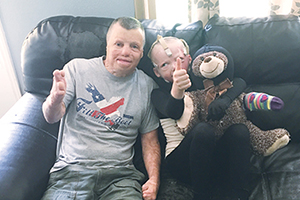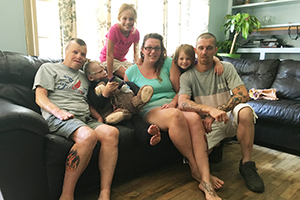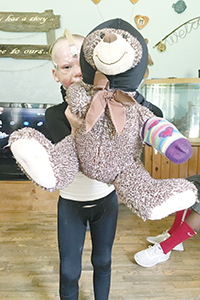By RENEE STOVSKY
Darcy Layman says she will never forget the first moment her family's life changed forever. It was at 8 p.m. on March 19, 2018.
Her husband, Gregory Layman, an over-the-road trucker, had just pulled a friend's 1981 Dodge into the garage at their home in Cassville, Mo. It was intended to be the centerpiece of a lengthy, father-son restoration project for Damian, 6.
While Darcy made dinner, Gregory fiddled with the Dodge. When he asked her to come out and turn over the engine so he could check out a problem, she told Damian and his sisters, Sage, 9, and Harmony, 5, to wash up in the laundry room next to the garage.

The supportive bond that Kc Kopaska forged with 6-year-old Damian Layman has helped the boy cope as he recovers from burns. Kopaska, a pastoral care provider who counsels burn patients at Mercy Hospital Springfield, says: "My scars speak a message without me opening my mouth."
As she started the Dodge up, it backfired, and a huge fireball erupted. Damian ran out and immediately became engulfed in flames. His father grabbed him and tried to smother the fire. Because of his efforts, Damian miraculously escaped nose, mouth, throat, or lung damage. But doctors at Mercy Hospital Springfield, where Damian was rushed by ambulance, determined that the little boy had sustained third-degree burns over
40 percent of his body.
Damian was intubated in Mercy's ER, then put in a medically induced coma in the ICU, where he stayed until March 21.
It was there, Darcy says, that the second moment her family's life changed forever occurred. That was when Kc Kopaska, a Mercy pastoral care provider, arrived to offer his help and support.
"I was screaming and crying that first night in the hospital," Darcy recalls. "The next day Kc came in. My first thought when I looked at him was, 'Oh, my God.' But my second thought was, 'Thank God, you can understand.'"
That's because Kopaska, 60, is a burn survivor himself. And as a hospital chaplain, he says, "my scars speak a message without me opening my mouth."
Mad at the world
Over the next few months, Darcy says, Kopaska became their "ultimate support."
"Kc is a very upbeat person, but he told us the truth about what Damian was facing and didn't sugarcoat it," she says. "Our relationship with him has given us a huge advantage in coping with our son's ongoing recovery."
Damian was transferred to Shriners Hospitals for Children – Cincinnati on March 22 and stayed there 34 days, enduring multiple surgeries to graft skin to his face, torso and left arm, hand and leg. After a short recuperation in Cassville, he returned to Shriners in Cincinnati for more treatment.
After his second stay there, Darcy says, her son came home depressed and suffering from post-traumatic stress disorder.

Mercy Chaplain Kc Kopaska, left, boosts Damian Layman's spirits during emotional low points as the boy recovers from burns he suffered earlier this year. Kopaska became the Layman family's "ultimate support" after the accident. Pictured to Damian's right are his sister Sage, mother Darcy, sister Harmony and father Gregory.
"Damian has ASD (autistic spectrum disorder) and was really struggling emotionally. He told me he didn't want to live anymore and that we should have just let him die," she says. "Those are things you don't ever want to hear from your child."
The Laymans turned to Kopaska once more, hoping to boost Damian's spirits.
Ironically, the two had never spoken before Kopaska arrived at the Laymans' home with a teddy bear that Damian and he dressed together in an elastic bandage.
"Damian was mad at the whole world before he met Kc," says his mom. "He completely bonded with him, and that bear goes everywhere with him now."
The Laymans recently moved to Houston so Damian could access medical services at Shriners Hospitals for Children – Galveston, a pediatric burn hospital. These days, Damian and Kopaska talk by telephone or video chat.
"Kc's encouragement is invaluable. He gives all of us hope that this is a new beginning for Damian's life," says Darcy.
That hope comes from Kopaska's own life experience as a burn victim — and the ultimate rebirth it generated.
The fire within
Kopaska, who grew up in the tiny town of Crocker in central Iowa, says he was a "hell-bent" kid who drank hard liquor at 12 and had a serious drug habit by the time he was in junior high. In 1976, when he was 17, his aunt and uncle invited him to spend the summer with them in Colorado.
Kopaska got a job with a rancher. But on the first day he went out to bale hay, the Jeep he was riding in caught fire when the driver, also 17, lost control of the vehicle and a 5-gallon can of gasoline inside it exploded. Both boys were medevaced to the Brooke Army Medical Center burn unit at Fort Sam Houston in San Antonio. Only Kopaska survived, having endured a grueling 3 1/2-month stay at the hospital. He had sustained third- and fourth-degree burns over 60 percent of his body, as well as hearing loss, damage to his right eye and the loss of the first two digits on both of his hands.
It was while he was in the burn unit that Kopaska says he first started thinking about God. "I knew there was something bigger than what was going on in the hospital that kept me alive," he says.
But it was another five years — years filled with reconstructive surgeries as well as drugs and alcohol — before a seriously depressed Kopaska landed in the psychiatric ward of a Des Moines, Iowa, hospital and says he decided to surrender himself to Jesus.
Called to ministry
Kopaska enrolled in Open Bible College in Des Moines in 1981. "The wagon of sobriety was bouncy as heck," says Kopaska, but he prevailed, met his future wife, Diane, and completed the four-year program there. After that, the couple attended the Assemblies of God Theological Seminary in Springfield, Mo., and started their ministry at Central Indian Bible College in Mobridge, S.D. Six years later, they went to the Pacific Northwest to minister to various Native American tribes in Washington.
The Kopaskas, who now have two grown children, returned to Springfield in 1999, and Kc later served as a fire and police chaplain for 10 years. It was during that time that he first met a Mercy EMS chaplain and became intrigued with institutional chaplaincy. He took postgraduate training in pastoral clinical education, did a yearlong residency and began working for Mercy Hospital Springfield, first on a prn basis, and full-time since 2017.
"I have a ton of life experience that enhances my pastoral ministry, from my substance abuse to my cross-cultural ministry with Native Americans and my ministry with firefighters and police," says Kopaska, who cares for patients in Mercy's Level I burn unit as well as the ER, ICU and medical surgical department.

Damian with the bear Kopaska gave him when they first met. Together, they added the striped bandage.
"But it is my experience as a hospital patient that very quickly helps me establish therapeutic rapport with people. I give them hope. They see me and think that if I could make it through everything I experienced as a burn patient, they can make it through whatever they are experiencing too."
He adds: "Especially in the burn unit, I can journey along with patients because I understand chronic pain. I know what it's like to be confined to a small hospital room while life is passing you by. I know the feeling of being overwhelmed, of wondering what life is going to be like when you finally get out. And I can help them normalize their fears and their feelings."
Surviving vs thriving
Darren Tourville, manager of pastoral services at Mercy, says Kopaska is one of those people who runs towards a crisis, not away from it.
"With Kc, what you see is what you get — he's very authentic, very real. For a few patients and their families, especially in the burn unit, Kc's physical appearance may be too raw in the moment. But most people are very inspired by his presence and his story," he says.
Kopaska, he adds, is not content to have either himself or his patients be labeled burn survivors. That's why he's recently started a support system called Burn Thrivers. He reaches out to patients after they've been released from the hospital to let them know they are not alone, that someone cares. And he sees them at follow-up treatments, sharing experiences and resources among them.
Tourville thinks that philosophy — to not just survive but thrive — is the key to Kopaska's personal as well as professional success.
"Kc has an adventurous spirit. He runs marathons and climbs mountains. And his physical limitations only make him more determined," he says.
Though Kopaska admits to moments of discouragement, he says he draws his strength from his faith and from nature.
"I'm nondenominational — a Pentecostal who adheres to Calvinist and Baptist ideas, and, since working at Mercy, has immense respect for Catholicism, particularly its teachings about the dignity of all of God's children," he says. "That blended faith, plus my love for all things
outdoors — camping, hiking, gardening, just listening to bugs and birds in my backyard — are my coping mechanisms."
Says Tourville: "Kc has admitted to having moments of pity — 'God, why me?' But he says he is almost thankful for what he has endured now because of the positive impact he can have on other people's lives."
"I want to inspire people to believe in themselves — to never give up," says Kopaska. "Life is out there; you've just got to learn to live it."
Copyright © 2018 by the Catholic Health Association
of the United States
For reprint permission, contact Betty Crosby or call (314) 253-3490.